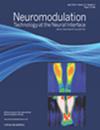A Mechanistic Analysis of the Neural Modulation of the Inflammatory System Through Vagus Nerve Stimulation: A Systematic Review and Meta-analysis
IF 3.2
3区 医学
Q2 CLINICAL NEUROLOGY
引用次数: 0
Abstract
Objective
We aimed to conduct a systematic review and meta-analysis assessing the antiinflammatory effects of various VNS methods while exploring multiple antiinflammatory pathways.
Materials and Methods
We included clinical trials that used electrical stimulation of the vagus nerve and assessed inflammatory markers up to October 2022. We excluded studies lacking control groups, those with combined interventions, or abstracts without full text. We adhered to the Preferred Reporting Items for Systematic Reviews and Meta-Analyses guidelines and the Cochrane Handbook for Systematic Reviews. For each inflammatory marker, a random-effects meta-analysis using the inverse variance method was performed. Methods used include transcutaneous auricular VNS (taVNS), transcutaneous cervical VNS (tcVNS), invasive cervical VNS (iVNS), and electroacupuncture VNS (eaVNS). Main reported outcomes included tumor necrosis factor (TNF)-α, interleukin (IL)-6, IL-1ß, C-reactive protein (CRP), and IL-10. Risk of bias was evaluated using the Cochrane Collaboration Tool (RoB 2.0).
Results
This review included 15 studies, involving 597 patients. No statistically significant general VNS effect was observed on TNF-α, IL-6, and IL-1ß. However, CRP, IL-10, and interferon (IFN)-γ were significantly modulated by VNS across all methods. Subgroup analysis revealed specific stimulation techniques producing significant results, such as taVNS effects in IL-1ß and IL-10, and iVNS in IL-6, whereas tcVNS and eaVNS did not convey significant pooled results individually. Cumulative exposure to VNS, higher risk of bias, study design, and pulse width were identified as effect size predictors in our meta-regression models.
Conclusions
Pooling all VNS techniques indicated the ability of VNS to modulate inflammatory markers such as CRP, IL-10, and IFN-γ. Individually, methods such as taVNS were effective in modulating IL-1ß and IL-10, whereas iVNS modulated IL-6. However, different VNS techniques should be separately analyzed in larger, homogeneous, and powerful studies to achieve a clearer and more consistent understanding of the effect of each VNS method on the inflammatory system.
通过迷走神经刺激对炎症系统进行神经调节的机制分析:系统回顾与元分析》。
目的我们旨在进行一项系统性综述和荟萃分析,评估各种 VNS 方法的抗炎效果,同时探索多种抗炎途径:我们纳入了截至 2022 年 10 月使用迷走神经电刺激并评估炎症标志物的临床试验。我们排除了缺乏对照组、联合干预或无全文摘要的研究。我们遵守了《系统综述和元分析首选报告项目》指南和《科克伦系统综述手册》。对于每种炎症标记物,我们都使用反方差法进行了随机效应荟萃分析。采用的方法包括经皮耳道 VNS(taVNS)、经皮颈椎 VNS(tcVNS)、侵入性颈椎 VNS(iVNS)和电针 VNS(eaVNS)。报告的主要结果包括肿瘤坏死因子(TNF)-α、白细胞介素(IL)-6、IL-1ß、C反应蛋白(CRP)和IL-10。采用 Cochrane 协作工具(RoB 2.0)对偏倚风险进行了评估:本综述包括 15 项研究,涉及 597 名患者。未观察到 VNS 对 TNF-α、IL-6 和 IL-1ß 有统计学意义的普遍影响。不过,VNS 对 CRP、IL-10 和干扰素 (IFN)-γ 的调节作用在所有方法中都很明显。亚组分析显示,特定的刺激技术产生了显著的结果,如 taVNS 对 IL-1ß 和 IL-10 有影响,iVNS 对 IL-6 有影响,而 tcVNS 和 eaVNS 没有单独产生显著的集合结果。在我们的元回归模型中,VNS的累积暴露、较高的偏倚风险、研究设计和脉冲宽度被确定为效应大小的预测因素:结论:汇总所有 VNS 技术表明,VNS 能够调节 CRP、IL-10 和 IFN-γ 等炎症指标。就个体而言,taVNS 等方法能有效调节 IL-1ß 和 IL-10,而 iVNS 则能调节 IL-6。然而,不同的 VNS 技术应在规模更大、同质化更强的研究中分别进行分析,以便更清晰、更一致地了解每种 VNS 方法对炎症系统的影响。
本文章由计算机程序翻译,如有差异,请以英文原文为准。
求助全文
约1分钟内获得全文
求助全文
来源期刊

Neuromodulation
医学-临床神经学
CiteScore
6.40
自引率
3.60%
发文量
978
审稿时长
54 days
期刊介绍:
Neuromodulation: Technology at the Neural Interface is the preeminent journal in the area of neuromodulation, providing our readership with the state of the art clinical, translational, and basic science research in the field. For clinicians, engineers, scientists and members of the biotechnology industry alike, Neuromodulation provides timely and rigorously peer-reviewed articles on the technology, science, and clinical application of devices that interface with the nervous system to treat disease and improve function.
 求助内容:
求助内容: 应助结果提醒方式:
应助结果提醒方式:


